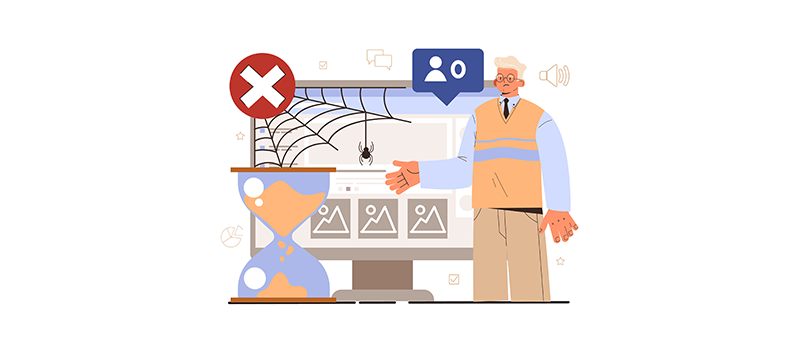The beginning of a new year is a great time to evaluate your affiliate marketing strategy and set yourself up for success. Many affiliate marketers start off the year by setting a revenue goal, studying the competitive landscape, and putting together a plan for reaching their goals. Although setting goals is important, it’s equally important to avoid falling into common pitfalls to reach your goals for the year. In this post, we’ll cover five of the most common affiliate marketing mistakes and how to avoid falling into them.
1. Promoting too many products
One of the most common mistakes made by affiliate marketers is spreading themselves too thin by promoting too many products. It can be enticing to start promoting as many products as you can, so you can have more streams of income. Although this works in theory, it often leads you to make less money. It’s much better to find a handful of affiliate programs that pay well and you like to promote instead of promoting everything. When you focus on a few products, you can devote more time to creating quality content for those specific products.
It’s better to focus on building your brand as a trusted source and monetize your audience afterward.Your audience will remember your brand through a distinctive logo design and content. Instead of chasing short-term sales, focus on positioning yourself as an authority in a given niche. You can review different products in that niche via blog posts and/or videos. The more you can build an audience, the easier it will be to promote affiliate products and convert your audience into affiliate sales.
2. Producing bad content
The majority of affiliate marketers drive traffic to their affiliate partners via content. The most popular form is generally blog posts, but some other notable mediums include YouTube videos, and TikToks. In general, the larger and more engaged your audience is, the better your affiliate promotions will perform. Most affiliate marketers make the mistake of taking shortcuts with content quality in order to make a lot of content.
For example, be careful when using AI writing tools to generate content, without editing it, reviewing it and making it interesting to read for humans. Although this may seem like the right thing to do, it can end up having a negative impact on your long-term success.
Poor content often leads to little to no engagement in the posts you create. If visitors are bouncing off your content immediately, algorithms on platforms like Google or YouTube will push your content down and recommend better-performing content. This can make it increasingly hard to get organic traffic, leading to you having to rely on paid channels like Google Ads or Facebook Ads to get traffic to your affiliate pages.
3. Poor or no analytics
Analytics is the backbone of affiliate marketing. Most affiliate marketers know affiliate marketing is a number’s game, but you’re only as good as the data you’re monitoring. The problem is that many affiliate marketers don’t have a system in place to track their analytics. Without this, you’re taking a wild guess in terms of traffic, conversions and any other metric. These analytics are often what enable you to do A/B tests on your copywriting, landing pages, etc.
If you don’t have any analytics, the first step you should take is to use the free resources available on the platform you’re promoting your products on. For example, if you have a blog, you can leverage Google Analytics to get an accurate count of how many times your pages are viewed, how many people click on a link and how many people convert. Having this data is key to making smarter decisions when it comes to affiliate marketing.
4. Forgetting to update old content
In addition to poor analytics, many affiliate marketers forget to update old content. Most affiliate marketers add tags that indicate the year on their content. Examples of this include titles like “Best CRM of 2023” or “Best Affiliate Marketing Software for 2022”. Although those titles drove traffic in a given year, you’ll need to update your titles or your conversion rates will drop dramatically. This is especially important for SEO because you’ll need to update content regularly in order to maintain your rankings.

You can start updating your old content by searching for titles with a year mentioned. If you browse through your blog or video catalog, you can easily find them and update them. In addition to the title, it’s important to update any relevant content. This will make it easier for your audience to get more accurate content. You can also opt to make new content with the new year in the title. This is the best option if you have the time to create new content.
5. Doing affiliate marketing on your own
Affiliate marketing is always rapidly evolving and it’s helpful to surround yourself with like-minded professionals to take your business to the next level. When you’re doing affiliate marketing on your own, it can be overwhelming to keep up with the different changes in SEO, affiliate programs, and other factors that directly impact your business. If you joined a community of affiliate marketers, you can learn from other marketers’ mistakes and adapt easier to changes in your business. Connect with a network and exchange ideas. Keep your communication going with a service VoIP system as a professional business practice.
You don’t need to take a course or do anything substantial to join a group. You can start finding affiliate marketing communities on Facebook Groups, Reddit, Twitter, YouTube, etc. The more you surround yourself with other affiliate marketers, the more you can learn and quickly tweak your marketing strategy. JVZoo has a free affiliate marketing group you can join on Facebook. You can get access to free weekly training and join a community of successful affiliate marketers. You can request to join the Facebook Group here.

